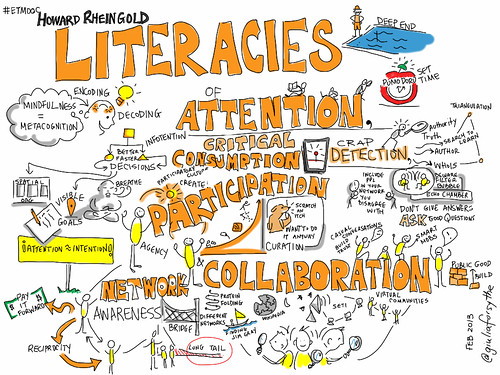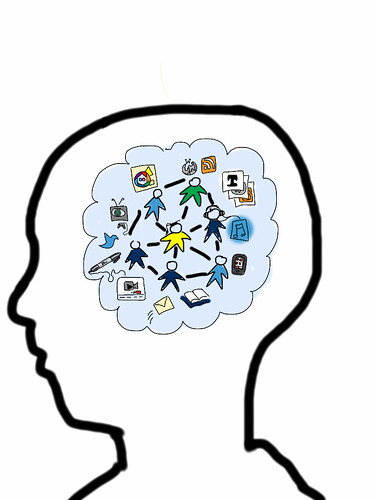Visualization of Timothy Gower’s blog post that spurred the online petition to boycott the closed access and very expensive publisher Elsevier.
Visualization of Timothy Gower’s blog post that spurred the online petition to boycott the closed access and very expensive publisher Elsevier.
Visual notes of Zack Dowell describing forest gardening for his master gardening class live on #ds106radio
I’m excited to be a guest in #ds106 this evening for Week 6: It’s All Designed. Of course, DS106 is not like any other MOOC and is not big on the M part of the MASSIVE, but its specialness is important to reiterate in this time of MOOC madness.
I’m hoping some of the students take up @cogdog‘s suggestion to do one of the assignments I submitted, Learning by Design.
I’ve done many visual notes of talks over the past couple years, but I’m always happy to do a new one. Luckily, this week I was able to catch the inimitable Howard Rheingold‘s interactive and informative talk to Alec Couros‘ successful experiment in community-course-MOOC, ETMOOC.
After the session I reflected a lot on the intersection of my note taking, attention, participation, and critical consumption. This spurred pages of reflections which then stalled me from hitting the publish button. (THIS ALWAYS HAPPENS!)
I get so caught up in all the connections of ideas that run through my mind that I have a hard time creating a coherent post. Of particular note, this is extremely relevant to the ETMOOC topic this week about digital literacies. If I am not a part of the participatory culture and all I do is send out a doodle of some key words with cute stick figures, how am I contributing?

cc licensed ( BY NC SA ) flickr photo shared by giulia.forsythe
Some presenters really like the drawings, others not so much. I showed my daughter the drawing from Howard’s talk and she said, “that’s just a confusing jumble of words”. Hmmm, much like my brain, jumping from one idea to the next. Great ideas come this way, but also great procrastination.
A post of coherent thoughts often gets mired down by my attention, or inattention as the case may be. I loved Howard’s suggestions about dealing with all the things that cross your desk in a day and prioritizing so that your ATTENTION matches your INTENTION. Today, I made a list, as he suggested, of all the things I want to accomplish. This post is one of them. Harnessing the power of my attention is definitely a goal for me today.
Keeping my attention is not a new problem. In the days long before cell phones and laptops, I often had difficulty paying attention in university lectures. I simply would fall asleep. My notes started very tidy and organized but after about 20 minutes they would devolve into almost electrocardiogram style notes just barely registering my pulse.
In biology class, I noticed that if I started doodling I was able to stay awake and I tended to remember what the prof was saying. Sadly, I didn’t do this often because I was embarrassed about my doodling. Doodling was decidedly NOT academic.
I’ve since learned that taking notes visually has helped me maintain my focus and learn more.
If I could travel back in time, I’d give my teenage self the permission to draw as much as she wanted during lecture. In the absence of time travel, the best thing I can do to contribute to a better learning environment is to encourage doodling in more university classes.
Now that I work in educational development and am a part of a great network of learners and teachers, I have had the pleasure to listen to some of the greatest teachers and they incorporate numerous ways for learners to keep their attention on learning. In ETMOOC, I’ve attended a couple sessions and the use of the whiteboard and chat as a way for learners to share their perspectives is really great. Unfortunately, JAVA is still forbidden at my university so I only connected via the iDevice Application. This NO Java situation is fairly good, you can listen, watch the slides read & type in the chat, but unfortunately no whiteboard ability. As such, I decided to continue on with my drawing of notes vs interacting directly.
I learned from Howard’s talk that 5% of the population can multi-task. That is definitely not me. Taking notes is not multi-tasking for me. It is an integral part of my listening. It allows me to make immediate connections to the things I hear and prevents my mind from drifting onto other topics. This comes at a cost, I cannot do much else than draw and listen. No chatting, no tweeting.
In addition to what was happening in the chat, whiteboard and probably twitter, Howard had the folks in the group also volunteer to retrieve links and provide context to the links inside an etherpad.
We’ve been using etherpads and wikis here at Brock and it’s always great to see such rich uses of collaborative editing documents.
In situations where there is really great pedagogy at play, taking visual notes is extremely difficult and perhaps unnecessary. Par of me wishes I had participated fully in Howard’s talk and then did visual notes afterwards on my reflections on the enduring learning.
This type of metacognition or mindfulness about my strengths and weaknesses, learning preference and learning goals are all part of what Howard called infotention. Awareness of these factors should allow me to make better, faster decisions next time; knowing when to listen and when to participate and when to do both.
This is what literacy means to me. It’s personal but it’s evolving, so sometimes it should be public and shared.

cc licensed ( BY NC SA ) flickr photo shared by giulia.forsythe

Turn ideas into pictures!
Visualize a blog post, TED Talk, Class lecture or even dense text from a book- through drawing. Use the pictures to symbolically represent & concretize abstract concepts, and to make connections between ideas. Try to use words sparingly and only to reinforce your imagery.
Doodle it in your notebook, use your tablet, or scribble it on the back of a napkin. Just be sure to digitize it and then blog about the process, including citing where your inspiration came from.